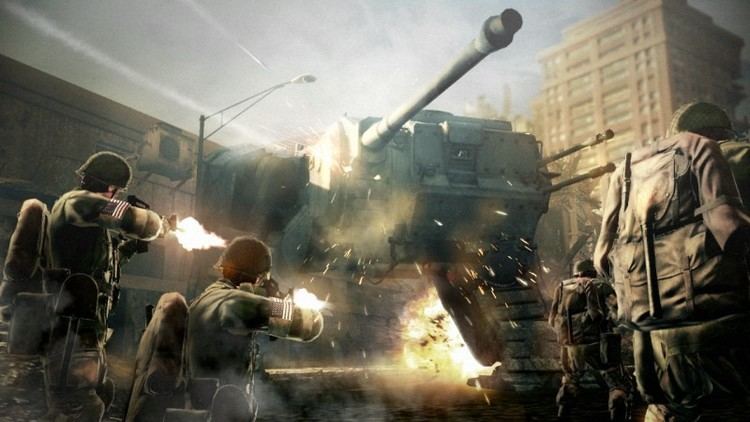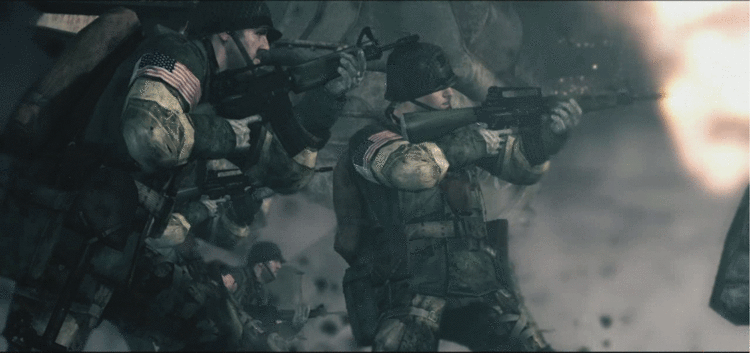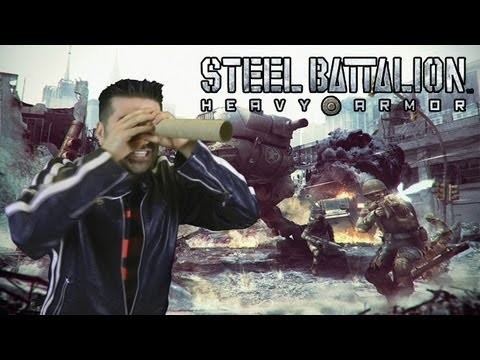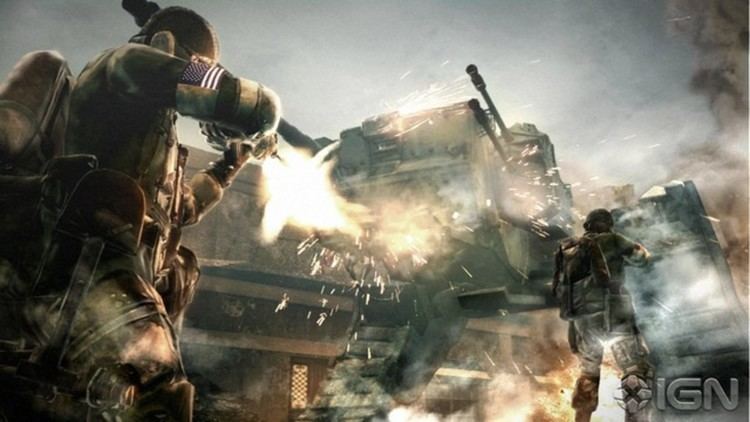3.4 /10 1 Votes3.4
38% Metacritic Designer(s) Kazuhiro Hamatani Artist(s) Daisuke Satake Initial release date 19 June 2012 | 3/10 IGN Director(s) Isamu OkanoYukio Ando Programmer(s) Takeshi Suzuki Composer(s) Yoshikazu Takayama Platform Xbox 360 | |||||||||||||||||||||||||||||||||
 | ||||||||||||||||||||||||||||||||||
Producer(s) Tatsuya KitabayashiMasanori TakeuchiKenji Kataoka Modes Single-player video game, Multiplayer video game Similar FromSoftware games, Vehicle simulation games | ||||||||||||||||||||||||||||||||||
Steel battalion heavy armor angry review
Steel Battalion: Heavy Armor (Japanese: 重鉄騎, Hepburn: Jūtekki) is a video game developed by FromSoftware and published by Capcom for the Xbox 360. Released worldwide in June 2012, it is a sequel to both Steel Battalion and Steel Battalion: Line of Contact on the Xbox. It was announced at the 2010 Tokyo Game Show, and requires the Kinect sensor. The game uses a combination of the standard Xbox 360 controller and the Kinect for gameplay.
Contents
- Steel battalion heavy armor angry review
- Steel battalion heavy armor review ign video review
- Gameplay
- Setting
- Plot
- Development
- Reception
- References

Steel battalion heavy armor review ign video review
Gameplay

The gameplay takes place inside a tank-like bipedal robot, known as a Vertical Tank (VT, veet, or Victor Tango), which the player and their crew control. The player is tasked with completing series of missions, which include destroying set targets, clearing areas of enemies or providing defense for military units. During these missions, the player must monitor enemy movements while coordinating with their crew members inside the robot, dealing with both interior and exterior threats. The player's crew, and other military units, can be killed, injured or suffer from other problems during battle, forcing the player to stay on alert and improvise during situations; killed crew members would also be replaced with other crew members, or their position would be left empty in consecutive battles, which would cause the player to have to fill in for their duties.

The game uses Kinect software, which coordinates the player's movements to their actions in the game. However, the limited control of the Kinect software combined with the need for precise movements in-game led to the game being nearly unplayable for some, due to the erratic and unresponsive controls.
Setting

Steel Battalion: Heavy Armor takes place in the year 2083, 63 years after the "Datacide", a catastrophic event in which the world's supply of computer technology is destroyed due to a silicon-eating microbe that started destroying all microprocessors in 2020. As a result, military technology is reduced to rudimentary weapons, including the Vertical Tank, a large bipedal robot which is operated by a four man crew: a pilot, left loader who doubles as a engine starter, a radio operator, and a right loader.

China, because of its huge industrial complex, becomes the new world superpower; taking over the United Nations and soon begins to dominate the world, both economically and militarily. On November 19, 2081, China, supported by the Chinese led-UN, launch a savage but swift blitzkrieg against the United States, reducing the country from fifty to eight states: Tennessee, Mississippi, South Carolina, North Carolina, Georgia, Florida, Alabama and the new elevated state of Puerto Rico (with San Juan as the new capital of the US), before a ceasefire was declared. The Chinese led-UN is colloquially referred to as "Uncle" by the United States military.
Plot
The story follows Sergeant Powers, a VT pilot, and the crew of his VT as they battle UN forces. The initial crew consists of Natch, Rainer, and Parker. During the course of the game, the crew sometimes switches from different members of Powers' platoon who may or may not be killed during gameplay which in turn may affect the crew over the course of the game.
On March 17, 2083 the United States military runs an amphibious landing operation to retake the now occupied New York City using Vertical Tanks as the primary attack force. The troops, with the help of the VTs, are able to take New York City and establish a foothold on the Mainland. After clearing New York City of the remaining enemy troops, Sergeant Powers and his crew are tasked with a series of missions, including the destruction of several ammunitions depots, a radio array, a series of decoys to draw the enemy's attention and the capture of a naval harbour in Norfolk, Virginia in order to disrupt the naval supply lines of the Chinese-UN, which is mounting a heavy counter-attack. After a vital mission to retrieve a microfilm from an American spy in the UN, it is revealed that the UN is developing the new generation of VT called the Heavy Vertical Tank (HVT) in Berlin (after a war in Europe, Germany joined the UN, and is now a close partner with China), whose prototype proved highly successful in destroying Russian forces in Siberia (which is now a China controlled territory), with American citizens being captured and sent to Berlin as "test subjects".
The US military eventually decide to launch an offensive on Berlin, but since the remaining US forces in Europe are stranded in Libya, the military decide to mount an assault on Colorado Springs, Colorado where the main airbase of the UN in North America is situated in order to stop the bombardments on New York City and to secure the supply lines to Libya. After taking control of the UN airport, the battalion is shifted to Morocco, where the US forces are preparing an assault on the Gibraltar Strait to reach Berlin. However, during a supply run in a UN-controlled refinery, the battalion is ambushed by the HVT, which kills the battalion leader, Lieutenant Straw, before the battalion are able to damage it, destroying the entire refinery in the process. Rejoining with the US forces in Libya, Powers is promoted as new Lieutenant and leader of the battalion, and is tasked a series of missions before leading the attack on the Gibraltar Tunnel (which connects Africa with Europe). During one of the missions, Powers' battalion manage to seize a damaged HVT, revealing that the HVT is piloted by only one person in the cockpit and another in a hidden seat, who, the US intelligence finds out from his body, underwent a series of physiological modifications and is connected with the HVT by a series of cables. During the attack on the Gibraltar Tunnel, the US forces destroy all UN enemy forces in the area (including one of the HVTs), with this victory and the fact that, the Russian Army is launching a massive attack against the Chinese-UN forces in Europe along the border with the city of Warsaw, the UN has no choice but to retreat its forces from Spain and lift the pressure on America by retreating its East Coast forces to face the invasion on Europe.
The US military takes advantage of the situation to launch a coordinated invasion of France, the invasion proves successful in taking Paris and destroying a military fort used to replenish the HVT's Human Processing Unit (HPU), which are in fact human prisoners of the UN turned into biological processors (the second "pilot" of the HVT). En route to Paris, it is possible for Parker to be killed while sacrificing himself to protect the crew from a grenade thrown into the VT. The US Military receive intelligence information suggesting that Russia and the UN have called a ceasefire, to avoid the UN's opportunity to crush the US forces in Western Europe, the US command decide to speed up the advance of its forces into Germany, which however puts pressure on Lieutenant Powers, after he receives news that his daughter (who disappear during the China-UN invasion of America in 2081) is now a CI (Civilian Internee) inside a UN labor camp. In the end, the US military command's concerns prove unnecessary since talks between Russia and the UN soon break apart and the conflict resume, to support the Russian advance in Europe the battalion is tasked the mission of destroying a railway gun used by the Chinese to keep the Russians in check at Dresden, once destroyed, the Russian and American military command agree to a joint mission to attack the HVT-factory in Berlin, where Powers' crew, aided by the Russians, manage to penetrate the factory and destroy several incomplete but still deadly HVTs, taking control of the factory itself. Following this, the Chinese Leader of the UN is killed in Coup d'état which leaves his protégé, Colonel Mao, as the full commander of the UN military.
In the aftermath, the American-Russian task force attack Berlin, breaking through the UN lines after destroying a black heavily armoured HVT (the last new model) and managing to seize Dr. Hamlin (the head of the HPU program), who decides to defect in exchange of asylum. Unfortunately, even if Powers' crew manage to protect the train that is transporting Hamlin and his team from the UN forces, the train is later ambushed and destroyed by the UN. Unwilling to let Colonel Mao escape back in China with the data of Hamlin's research, the American-Russian command launch an attack to Mao's fort and research lab just outside of Berlin, opening the way to American troops in the fort (freeing hundreds of American CI's imprisoned in the fort) and destroying the personal black-HVT of Mao. However, Colonel Mao activates the missiles stored in the fort, in order to make them self-destruct and kill everyone within miles of the fort. Natch volunteers to go out of VT toward the central computer to stop the countdown.
Mao manages to leave his black-HVT and attempts to stop Natch. If the Powers is able to kill Mao, Natch returns to the VT successfully and survives the mission. If Powers is unable to kill Mao in time; after the countdown being stopped, Mao kills Natch before killing himself. As Powers rushes to Natch, the point-of-view of Powers' daughter is seen inside Mao's black HVT as a HPU, seeing her father one last time before apparently dying. Later on, a radio report, reveals that the US has liberated the rest of the Continental US and that Russia is advancing in Siberia, with the UN and China willing to reach a compromise with both countries, ensuring that the war is now finally over.
If the Player manages to complete the campaign with none of the platoon members dying, a bonus cinematic plays in which Powers leads the platoon with the crew optimistic about their upcoming battle with Russian forces, dialogue implying that Powers' daughter survived her internment as a CI.
Development
The first Steel Battalion required players to control the game with a $200 special controller, Capcom was unwilling to make such a requirement for a 360-game and for a while it looked like the franchise was dead. This was until Microsoft began showing an early version of Kinect (then named Project Natal) to developers and publishers at which point producer Tatsuya Kitabayashi realized that the series could work with the new motion based controller. Describing the first game as "limited by the controller", Kitabayashi recognized that the Kinect could allow much more movement than the original game could provide Because the game uses both the controller and the Kinect, Capcom had to seek special permission from Microsoft as their certification rules normally require that use the controller or the Kinect, but not both.
Capcom chose to work with FromSoftware from their work on Chromehounds, the Armored Core series as well as their work on Dark Souls. Capcom and FromSoftware worked to make sure that the game was not too easy, although in an interview with Digital Spy, producer Kenji Kataoka noted it was not as difficult as Dark Souls.
The game's original score was written by Yoshikazu Takayama. Motoi Sakuraba, who had previously worked with FromSoftware on Dark Souls, wrote the game's main theme.
Reception
Steel Battalion: Heavy Armor was widely panned by critics for being nearly unplayable due to the inability of the Kinect to accurately read the player's movements. It received a score of 40.95% on GameRankings and 38/100 on Metacritic. X-Play gave it a 0.5/5, being the lowest rating ever given by G4. while Giant Bomb gave it 1 out of 5 stars.
